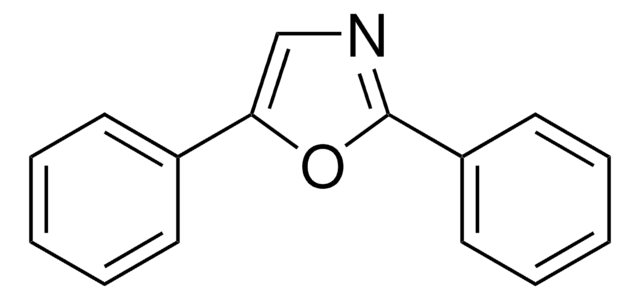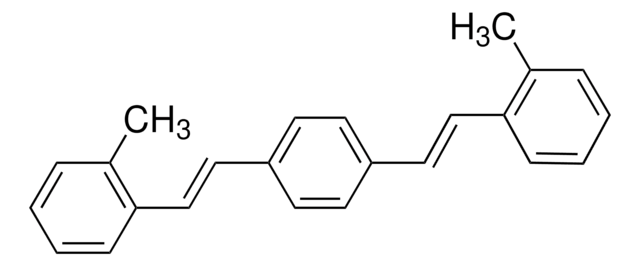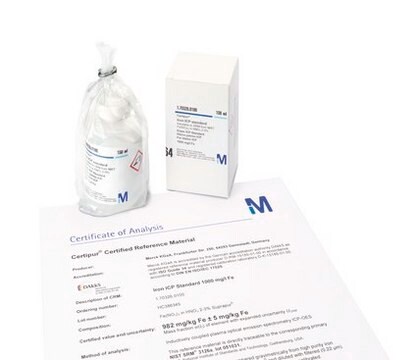D4630
2,5-Diphenyloxazole
suitable for liquid scintillation spectrometry
Synonym(s):
DPO, PPO
Sign Into View Organizational & Contract Pricing
All Photos(3)
About This Item
Empirical Formula (Hill Notation):
C15H11NO
CAS Number:
Molecular Weight:
221.25
Beilstein:
157021
EC Number:
MDL number:
UNSPSC Code:
12352100
PubChem Substance ID:
NACRES:
NA.22
Recommended Products
form
powder
bp
360 °C (lit.)
mp
72-74 °C (lit.)
suitability
suitable for liquid scintillation spectrometry
SMILES string
c1ccc(cc1)-c2cnc(o2)-c3ccccc3
InChI
1S/C15H11NO/c1-3-7-12(8-4-1)14-11-16-15(17-14)13-9-5-2-6-10-13/h1-11H
InChI key
CNRNYORZJGVOSY-UHFFFAOYSA-N
Looking for similar products? Visit Product Comparison Guide
General description
2,5-Diphenyloxazole (also known as PPO or p-phenylphenoxazole) is a fluorescent organic compound. It can be also used as an organic scintillator due to its high photoluminescence quantum yield and intriguing luminescent properties. It is widely used as a fluorescent probe or dye in analytical chemistry and biochemistry.
Application
2,5-Diphenyloxazole (PPO) can be used in:
- fluorography techniques for the detection of tritium, tritiated glycopeptides, and 35S labeled proteins.
- liquid scintillation cocktails as primary and secondary fluors.
related product
Product No.
Description
Pricing
Storage Class Code
11 - Combustible Solids
WGK
WGK 3
Flash Point(F)
386.6 - 393.8 °F - closed cup
Flash Point(C)
197 - 201 °C - closed cup
Personal Protective Equipment
dust mask type N95 (US), Eyeshields, Gloves
Choose from one of the most recent versions:
Already Own This Product?
Find documentation for the products that you have recently purchased in the Document Library.
F M Williams et al.
British journal of clinical pharmacology, 22(3), 263-268 (1986-09-01)
As a substrate for human liver microsomes, ethoxyresorufin appears to be metabolised by a group of cytochrome P450 isoenzymes which are inducible by cigarette smoking. Kinetic studies in microsomes from four human livers indicate that only one enzyme component is
Emilee R Wilhelm-Leen et al.
American journal of kidney diseases : the official journal of the National Kidney Foundation, 66(1), 69-74 (2015-02-01)
Epoetin alfa (EPO) and darbepoetin alfa (DPO) are erythropoiesis-stimulating agents that are widely and interchangeably used for the treatment of anemia in patients with advanced chronic kidney disease and end-stage renal disease. No study has specifically compared the risks of
Gianluca Ambrosi et al.
Organic & biomolecular chemistry, 8(6), 1471-1478 (2010-03-06)
Synthesis and acid-base properties for three fluorescent polyamine macrocycles 9,12,15,24,25-pentaaza-26-oxatetracyclo[21.2.1.0(2,7).0(17,22)]hexaicosa-2,4,6,17,19,21,23,25(1)-octaene (L1), 9,12,15,18,27,28-hexaaza-29-oxatetracyclo[24.2.1.0(2,7).0(20,25)]enneicosa-2,4,6,20,22,24,26,28(1)-octaene (L2) and 9,12,15,18,21,30,31-heptaaza-32-oxatetracyclo[27.2.1.0(2,7).0(23,28)]diatriconta-2,4,6,23,25,27,29,31(1)-octaene (L3) are reported. Each ligand contains the 2,5-diphenyl[1,3,4]oxadiazole (PPD) unit incorporated in the polyamine macrocycle. The protonation constants of L1-L3 were determined by means of
Gianluca Ambrosi et al.
Inorganic chemistry, 49(21), 9940-9948 (2010-09-30)
The coordination properties and photochemical responses of three fluorescent polyamine macrocycles, 9,12,15,24,25-pentaaza-26-oxatetracyclo[21.2.1.0(2,7).0(17,22)]hexaicosa-2,4,6,17,19,21,23,25(1)-octaene (L1), 9,12,15,18,27,28-hexaaza-29-oxatetracyclo[24.2.1.0(2,7).0(20,25)]enneicosa-2,4,6,20,22,24,26,28(1)-octaene (L2), and 9,12,15,18,21,30,31-heptaaza-32-oxatetracyclo[27.2.1.0(2,7).0(23,28)]diatriconta-2,4,6,23,25,27,29,31(1)-octaene (L3), toward Cu(II), Zn(II), Cd(II), and Pb(II) are reported. Each ligand contains the 2,5-diphenyl[1,3,4]oxadiazole (PPD) moiety inserted in a polyamine macrocycle skeleton. The
Alessio Terenzi et al.
Dalton transactions (Cambridge, England : 2003), 41(15), 4389-4395 (2012-02-16)
The interaction of calf thymus DNA with [CuL(ClO(4))]ClO(4)·H(2)O (1) and [ZnLBr]Br·H(2)O (2) (L = 9,12,15,18,27,28-hexaaza-29-oxatetracyclo[24.2.1.0(2,7).0(20,25)]enneicosa-2,4,6,20,22,24,26,28(1)-octaene) dicationic complexes in aqueous solution at neutral pH, was investigated by variable-temperature UV-vis absorption, circular dichroism and fluorescence spectroscopy. The values of the DNA-binding constants
Our team of scientists has experience in all areas of research including Life Science, Material Science, Chemical Synthesis, Chromatography, Analytical and many others.
Contact Technical Service







